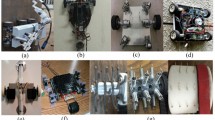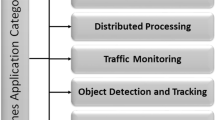Abstract
This paper proposes a novel method based on Fuzzy Logic Systems (FLSs) optimized to maximize the area coverage of a tiling robot by reconfiguring per an obstacle considering the “Infi” concept. The consideration of an infinite number of reconfigurable shapes by a tiling robot is defined as the “Infi” concept. The major advantage of the proposed method over state-of-the-art “Infi” methods is the ability to tune based on cost measurements without demanding an explicit set of training data. The optimization techniques, Genetic Algorithm (GA), Particle Swarm Optimization (PSO), and Simulated Annealing (SA), were used for tuning the FLSs. The FLSs tuned using these three techniques were compared with state of the art by considering hTetro through simulations. According to the statistical outcomes, the proposed method can significantly improve the area coverage compared to the conventional methods while providing performance and behavior similar to the existing “Infi” methods that demand training data. Thus, the work proposed in this paper would be of great interest for the development of a reconfigurable floor cleaning robot since the complete area coverage is a foremost feature expected from a floor cleaning robot.











Similar content being viewed by others
Availability of data and material
Not applicable.
Code availability
The codes of the algorithms could be provided upon request.The codes of the algorithms could be provided upon request.
References
Baca J, Hossain S, Dasgupta P, Nelson CA, Dutta A (2014) Modred: hardware design and reconfiguration planning for a high dexterity modular self-reconfigurable robot for extra-terrestrial exploration. Robot Auton Syst 62(7):1002–1015
Decker M, Fischer M, Ott I (2017) Service robotics and human labor: a first technology assessment of substitution and cooperation. Robot Auton Syst 87:348–354
Ellis PD (2010) The essential guide to effect sizes: statistical power, meta-analysis, and the interpretation of research results. Cambridge University Press, Cambridge
El-Sherbiny A, Elhosseini MA, Haikal AY (2018) A comparative study of soft computing methods to solve inverse kinematics problem. Ain Shams Eng J 9(4):2535–2548
Hägele M, Nilsson K, Pires JN, Bischoff R (2016) Industrial robotics. Springer handbook of robotics. Springer, Berlin, pp 1385–1422
Hagras H (2018) Toward human-understandable, explainable AI. Computer 51(9):28–36
Han M, Zhou J, Chen X, Li L (2016) Analysis of in-pipe inspection robot structure design. 2nd Workshop on advanced research and technology in industry applications (WARTIA-16). Atlantis Press, London
Ingber L (1996) Adaptive simulated annealing (asa): Lessons learned. Pol J Control Cybern 25(1):33–55
Kalouche S, Rollinson D, Choset H (2015) Modularity for maximum mobility and manipulation: control of a reconfigurable legged robot with series-elastic actuators. In: 2015 IEEE International Symposium on Safety, Security, and Rescue Robotics (SSRR), IEEE, pp 1–8
Khan A, Noreen I, Habib Z (2018) An energy efficient coverage path planning approach for mobile robots. Science and information conference. Springer, Berlin, pp 387–397
Kleiner A, Baravalle R, Kolling A, Pilotti P, Munich M (2017) A solution to room-by-room coverage for autonomous cleaning robots. In: 2017 IEEE/RSJ International Conference on Intelligent Robots and Systems (IROS), IEEE, pp 5346–5352
Kramer O (2017) Genetic algorithm essentials, vol 679. Springer, Berlin
Le AV, Arunmozhi M, Veerajagadheswar P, Ku PC, Minh THQ, Sivanantham V, Mohan RE (2018) Complete path planning for a tetris-inspired self-reconfigurable robot by the genetic algorithm of the traveling salesman problem. Electronics 7(12):344
Le AV, Nhan NHK, Mohan RE (2020) Evolutionary algorithm-based complete coverage path planning for tetriamond tiling robots. Sensors 20(2):445
Lee TK, Baek SH, Choi YH, Oh SY (2011) Smooth coverage path planning and control of mobile robots based on high-resolution grid map representation. Robot Auton Syst 59(10):801–812
Li S, Zhang Y, Jin L (2016) Kinematic control of redundant manipulators using neural networks. IEEE Trans Neural Netw Learn Syst 28(10):2243–2254
Liu H, Ma J, Huang W (2018) Sensor-based complete coverage path planning in dynamic environment for cleaning robot. CAAI Trans Intell Technol 3(1):65–72
Lopez-Franco C, Hernandez-Barragan J, Alanis AY, Arana-Daniel N (2018) A soft computing approach for inverse kinematics of robot manipulators. Eng Appl Artif Intell 74:104–120
Luo C, Yang SX, Li X, Meng MQH (2016) Neural-dynamics-driven complete area coverage navigation through cooperation of multiple mobile robots. IEEE Trans Ind Electron 64(1):750–760
Masera R (2019) Cyber-physical systems and the new socio-economic paradigm: technology, knowledge and human capital. Yearning for inclusive growth and development, good jobs and sustainability. Springer, Berlin, pp 99–112
Morris KJ, Samonin V, Anderson J, Lau MC, Baltes J (2018) Robot magic: a robust interactive humanoid entertainment robot. International conference on industrial. Engineering and other applications of applied intelligent systems. Springer, Berlin, pp 245–256
Muthugala MAVJ, Vega-Heredia M, Vengadesh A, Sriharsha G, Elara MR (2019) Design of an adhesion-aware façade cleaning robot. In: 2019 IEEE/RSJ International Conference on Intelligent Robots and Systems (IROS), IEEE, pp 1441–1447
Muthugala MAVJ, Samarakoon SMBP, Elara MR (2020) Tradeoff between area coverage and energy usage of a self-reconfigurable floor cleaning robot based on user preference. IEEE Access 8:76267–76275
Parween R, Shi Y, Parasuraman K, Vengadesh A, Sivanantham V, Ghanta S, Mohan RE (2019) Modeling and analysis of hhoneycomb-a polyhex inspired reconfigurable tiling robot. Energies 12(13):2517
Poli R, Kennedy J, Blackwell T (2007) Particle swarm optimization. Swarm Intell 1(1):33–57
Pourabdollah A, Wagner C, Aladi JH, Garibaldi JM (2016) Improved uncertainty capture for nonsingleton fuzzy systems. IEEE Trans Fuzzy Syst 24(6):1513–1524
Prabakaran V, Elara MR, Pathmakumar T, Nansai S (2017) htetro: A tetris inspired shape shifting floor cleaning robot. In: 2017 IEEE International Conference on Robotics and Automation (ICRA), IEEE, pp 6105–6112
Reddy KS, Panwar LK, Panigrahi BK, Kumar R (2018) Computational intelligence for demand response exchange considering temporal characteristics of load profile via adaptive fuzzy inference system. IEEE Trans Emerg Top Comput Intell 2(3):235–245
Rhim S, Ryu JC, Park KH, Lee SG (2007) Performance evaluation criteria for autonomous cleaning robots. In: 2007 International Symposium on Computational Intelligence in Robotics and Automation, IEEE, pp 167–172
Richardson K, Coeckelbergh M, Wakunuma K, Billing E, Ziemke T, Gomez P, Vanderborght B, Belpaeme T (2018) Robot enhanced therapy for children with autism (dream): a social model of autism. IEEE Technol Soc Mag 37(1):30–39
Romero-Martí DP, Núnez-Varela JI, Soubervielle-Montalvo C, Orozco-de-la Paz A (2016) Navigation and path planning using reinforcement learning for a roomba robot. In: 2016 XVIII Congreso Mexicano de Robotica, IEEE, pp 1–5
Rosenstein MT, Chiappetta M, Schnittman M, Pastore A (2016) Autonomous coverage robot. US Patent 9,408,515
Samarakoon SMBP, Muthugala MAVJ, Le AV, Elara MR (2020) htetro-infi: a reconfigurable floor cleaning robot with infinite morphologies. IEEE Access 8:69816–69828
Shi Y, Elara MR, Le AV, Prabakaran V, Wood KL (2020) Path tracking control of self-reconfigurable robot htetro with four differential drive units. IEEE Robot Autom Lett 5(3):3998–4005
Tamar Y, Tryber E, Herut Y, Golan O, Gilead A, et al. (2017) Autonomous pool cleaning robot. US Patent 9,790,700
Tan N, Hayat AA, Elara MR, Wood KL (2020) A framework for taxonomy and evaluation of self-reconfigurable robotic systems. IEEE Access 8:13969–13986
Varela-Aldás J, Miranda-Quintana O, Guevara C, Castillo F, Palacios-Navarro G (2019) Educational robot using lego mindstorms and mobile device. Int Conf Comput Sci. Springer, Electronics and Industrial Engineering (CSEI), pp 71–82
Veerajagadheswar P, Elara MR, Thejus P, Vinu S (2018) A tromino tiling theoretic approach to path planning in a reconfigurable floor cleaning robot. In: 2018 International Conference on Reconfigurable Mechanisms and Robots (ReMAR), IEEE, pp 1–8
Vonásek V, Košnar K, Přeučil L (2012) Motion planning of self-reconfigurable modular robots using rapidly exploring random trees. Conference towards autonomous robotic systems. Springer, Berlin, pp 279–290
Zhang L, Yang Y, Gu Y, Sun X, Yao X, Shuai L (2016) A new compact stair-cleaning robot. J Mech Robot 8(4):045001
Zhao Z, Chen W, Peter CC, Wu X (2016) A novel navigation system for indoor cleaning robot. In: 2016 IEEE International Conference on Robotics and Biomimetics (ROBIO), IEEE, pp 2159–2164
Zheng K, Chen G, Cui G, Chen Y, Wu F, Chen X (2017) Performance metrics for coverage of cleaning robots with mocap system. International conference on intelligent robotics and applications. Springer, Berlin, pp 267–274
Funding
This research is supported by the National Robotics Programme under its Robotics Enabling Capabilities and Technologies (Funding Agency Project No. 192 25 00051), National Robotics Programme under its Robot Domain Specific (Funding Agency Project No. 192 22 00058) and administered by the Agency for Science, Technology and Research.
Author information
Authors and Affiliations
Corresponding author
Ethics declarations
Conflict of interest
The authors declare that they have no conflict of interest.
Additional information
Publisher's Note
Springer Nature remains neutral with regard to jurisdictional claims in published maps and institutional affiliations.
Rights and permissions
About this article
Cite this article
Samarakoon, S.M.B.P., Muthugala, M.A.V.J. & Elara, M.R. Toward obstacle-specific morphology for a reconfigurable tiling robot. J Ambient Intell Human Comput 14, 883–895 (2023). https://doi.org/10.1007/s12652-021-03342-2
Received:
Accepted:
Published:
Issue Date:
DOI: https://doi.org/10.1007/s12652-021-03342-2




